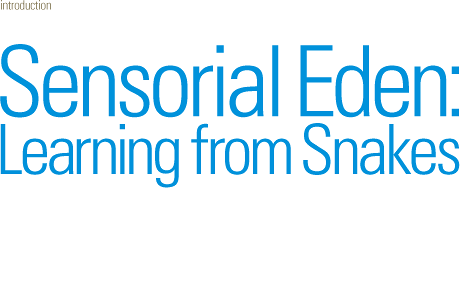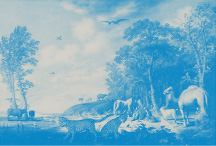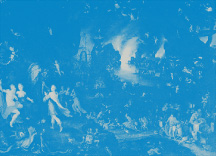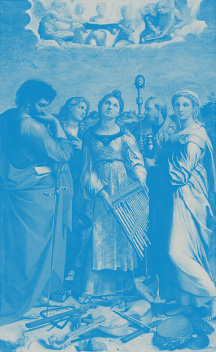There existed in the Garden of Eden, “the tree of life” and “the tree of knowledge,” the latter’s fruit which Eve and Adam ate, despite being forbidden to do so. Consequently, they were both expelled from Eden. So goes the episode of “Expulsion from Paradise” in the Old Testament. Upon eating it, direct cognition of truth becomes possible -- if this really was the function of the fruit of knowledge, and hence the prohibition against its eating, then the condition of Eden or paradise could be paraphrased as a place removed from truth.
‘The utmost hope of a person is to reach paradise’ ? From such an image, it seems only contradictory that paradise itself might be removed from ultimate knowledge. Why is this so? A simple answer relates to the characteristic of paradise. If paradise were defined as a place where sensorial pleasure is given, the possibility of directly knowing the existence of an object, or truth per se, would only make such sensations unnecessary. This brings catastrophe to the sensorial paradise that is Eden, for people would then be able to know the truth of their objects without resorting to any sensorial mediation.
Was Eden a literal ‘utopia,’ a non-existent place, where sensations are emancipated? This idea is hard to swallow, for it is none other than this mundane world that we now live in that brims with indirect knowledge via sensation and is thus prone to innumerable misconceptions and misunderstandings. And we should recall here that this mundanity was the very world reached after eating the fruit of knowledge and thus being expelled from paradise. In other words, since it occurred after truth was once attained, we have no other choice but to regard the various sensations that take place here as the source of misconceptions, misunderstandings, mistakes and conflicts (removed from the truth).
On the other hand, what if the fruit of knowledge had never been eaten? The difference between various innumerable sensations that humans (or animals) perceive each moment would never have been regarded as being reducible to the same singular truth or existence. They would never have been considered as merely deviated sensorial (subjective) impressions towards the same truth.
The many disparate sensations would instead be accepted as being each a fact on its own. It is not that there exist various different impressions or sensations toward an existence named apple (not that there exist innumerable subjective impressions towards a singular object). Each sensation would rather exist as an objective fact, no different from the apple’s existence.
If one were to admit equal rights to every unit of sensorial information that is variously perceived in each moment, they would obviously not be converged into a single object, nor would it be possible to say that they exist in the same singular space or time. There are neither differences nor hierarchies concerning truth and non-truth among these innumerable sensations.
Orpheus was a virtuosic lyre player in Greek myth. His lyre was loved not only by humans; if he was a true musical genius, then his lyre should have attracted animals, birds, fish, and all living creatures. Excepting, however, those who lacking audition.
Let’s take a look at this painting made by the Seventeenth Century Dutch painter Aelbert Cuyp. Orpheus looks somewhat glum. The animals gather around, attracted by the sound of his lyre. But there exists a clear hierarchy. Those who are near him are domestic animals. The more wild an animal is, the further away it is positioned. The most distant of them are the ostrich and elephant. Needless to say, the figure of snake is missing from this painting. And that is because it does not possess ears. More accurately, the organ which corresponds to the ear is buried under the skin of this animal who possess neither eardrums nor tympanum. Snakes do not hear vibrations of air, but only sense vibrations transmitted via the ground. The auditory sense of the snake is therefore tactile. Furthermore, snakes have bad eyesight and the articulation of their five senses remains ambiguous. Without the necessity of airborne mediation, snakes directly perceive sounds, vision and tactility through their bodies, and not as distanced sensation. The fact that it was the snake who talked Eve into eating the fruit of knowledge is indicative. And the lover of Orpheus, Eurydice, dies upon being bitten by the same animal.
Jan Brueghel the Elder painted the scene where Orpheus goes to the underworld to bring Eurydice back. But Orpheus somehow seems quite happy in the underworld. All the monstrous creatures (which includes probably the snake without ears) of the underworld listen and are mesmerized when Orpheus plays. In contrast to the world above, there is neither distance nor delay in the underworld. Because there is no hierarchy of sensations, there exist neither time nor space. The underworld knows no difference between truth and non-truth, nor any hierarchical degrees of reality.
If so, with what could Orpheus’ music have been heard in the underworld? The lack of distance precludes the necessity of ears and eyes. Rather, upon trying to see with eyes, light turns into salt, and upon trying to hear with ears, sounds turn, for instance, into flames. The eyes are blinded, the ears shut.
What the snake symbolizes is direct cognition, a knowing without distance, the transcendence of sensation. A snake is underworld per se, so to speak. They were thus regarded as beings who give death.
For instance Raphael created a painting of Saint Cecilia, the guardian saint of music, destroying musical instruments. The reason she commits such an atrocity is because musical instruments are nothing more than tools with which to domesticate sensations and audition that are destined for distance and delay within the limited time and space known as the mundane world. The music of the heavens must be heard without any instruments or distance. If this is true, however, the heavenly world will share too much of a resemblance with the underworld. Furthermore, it seems no different from the perverted yearning (I tasted truth/Idea before, and I want to taste it again; or in other words, I want to return to heaven) that one conceives by having eaten the fruit of knowledge. The longing, that is, to annul the sensorial differences and neutralize distance. What is known as Art often gives such perverted pleasures. The innumerable differences, conflicts, struggles that are displayed will sooner or later be dissolved, sublimated, synthesized, and attain harmony. But is this pre-fetched harmony the essence of music? Or the essence of Art? Doesn’t (the pre-attained and pre-cognized) harmony (to come), merely give death to the presently occurring sensation, likewise to the cognition that was handed from the snake (but is it really true that the snake gave this, when the only thing it did was to suggest eating the apple)?
Looking back once more, the heaven that Saint Cecilia longed for, and the world that existed in the Garden of Eden, have completely opposite characteristics. In Eden, there were only the various differences along with the pleasure of affirming them all. Each of these innumerable sensations existed there as facts (without being synthesized into a transcendental truth that stands above them), and so it had been accepted. In this sense, if a mountain in a distance appears smaller, this is not an illusion but a fact. Even if a mountain that upon measuring reaches the height of 3333m, looked nevertheless as 3cm, the mountain which looks 3333m and the mountain which looks 3cm are equivalent as sensorial facts. And no true mountain exists outside such sensations. It is the same for sound audition. A sound approaches us over time -- there is no music outside this very movement. This distance and delay is the essence of sensation, a fact of sound. It is not a deviation -- the difference between going from Nagoya to Osaka, from Nagoya to Nagano, or from Nagoya to Tokyo, is never explained as deviations or subjective views towards (or from) Nagoya. Or, the music listened to by a cat and the music listened to by a dog, even when played by the same performer, are not the same. As music, they are the same. Music is this movement which divaricates innumerably (similar to paintings). Each of them is an objective fact. Such a movement in various directions creates composite as objective fact, much like a constellation (which is none other than movement of light that we perceive as form)
There is the fallacious schema which distinguishes between sensation and existence, or sensation and truth (Idea). Existence and truth are cognitions rather than matter. Sensation is (a fact produced by matter, and therefore) a matter. You cannot eat existence or truth (a perverse illusion is to think that you can). What you can eat is sensation. We do not eat an apple. What we eat is none other than the sensation of red, like Cezanne thought (similar to the consumption of nutrition, we ingest light with our eyes and digest it as matter). That is why an apple is never the fruit of knowledge. An apple is rather a constellation created by innumerable sensations (to be sure, the image of constellation referred to here, is one for which an exterior observation point cannot be attained, like the solar system that we ourselves are part of). Musics are constellations. Paintings are constellations. They are composites created by the intersection of variously directed, materialistic (with cuts and grazes, even feverish and fricative) movements of innumerable sensations.
The snake who encouraged eating the apple must have known all this. For it is the body of the snake, which at times even swallows itself, that was composed in the manner of a constellation.




